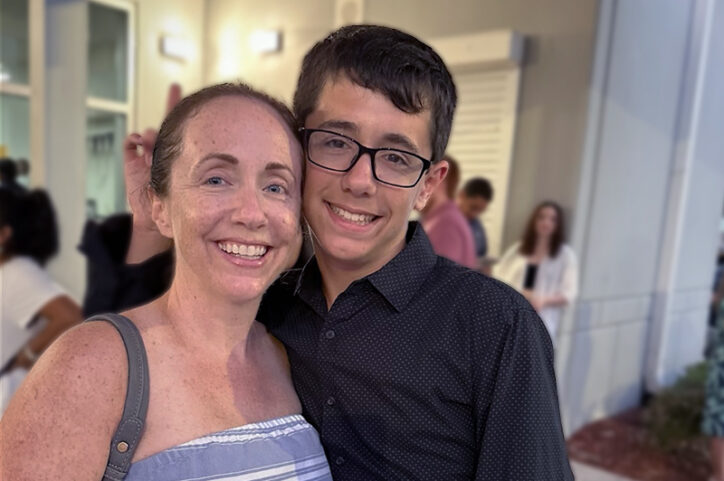‘Everything fell into place’: Innovative POEM procedure lets Peyton eat without pain

Peyton Reed, 14, is a typical teenage boy: He enjoys tennis, video games — and food. So when eating became so painful for him that he started losing weight, his parents knew it was time to get him help.
The problem began gradually enough five years ago, with bouts of what seemed liked heartburn. Because Peyton was young and the episodes were infrequent, it was difficult to pinpoint the cause. But when the pain began to get worse, Peyton underwent an upper GI series at a local hospital near his home in Southwest Florida. This test uses a special X-ray technology called fluoroscopy and a contrast agent called barium to show the upper part of the digestive system, including the esophagus, stomach, and the first part of the small intestine.
His mother, Renee, was in the room during the procedure and noticed something seemed amiss.
“I’m not an expert in gastroenterology,” says Renee, who is a registered nurse. “But when Peyton swallowed, it looked like the barium got stuck.”

‘Something was really wrong’
Nevertheless, Peyton’s test results were marked “normal” — and further testing, including a biopsy, didn’t show anything of concern either. Because Peyton’s doctors couldn’t find a cause for his symptoms, they told his parents that there was nothing they could do to treat him.
Yet the pain continued on and off with an irregular pattern. About a year later, Peyton experienced so much pain while out to dinner with his family that he had to leave the table and walk around the restaurant with tears in his eyes. “This was the worst the pain had ever been,” remembers Renee. “We knew something was really wrong.”
Although Peyton had an upcoming appointment at another Florida hospital, those doctors urged him to go to the emergency room rather than wait.
“That’s when things finally started changing,” says Renee.
Finally, a diagnosis
Peyton was admitted to that hospital, where he spent four days as an inpatient and underwent additional tests, including a repeat upper GI series. This time, it was clear that he was having difficulty swallowing. Although the hospital typically only performs other motility tests on adults, the clinical team there agreed that Peyton was mature enough to undergo them.
The result: a diagnosis of esophageal achalasia, a rare condition that makes it difficult to swallow and can lead to symptoms such as pain, regurgitation, and weight loss. Like many parents, the Reeds took to the internet in search of more information. One of Renee’s friends, who is also a nurse, researched the condition and learned about an innovative procedure that might help treat Peyton.
“Everything began to fall into place then,” says Renee.
POEM: A less invasive option
The procedure, called peroral endoscopic myotomy (POEM), is a less invasive way to perform myotomy, a surgical procedure that cuts the lower esophageal sphincter, allowing food and liquids to pass to the stomach. POEM has similar outcomes to myotomy, but with shorter hospital stays and recovery times. Although POEM has been used for over a decade to treat adults, just a few pediatric hospitals offer it, including Boston Children’s.
When Renee learned that Boston Children’s Dr. Peter Ngo was the first pediatric gastroenterologist in the U.S. to perform POEM, she reached out. “He called me back that day and we spoke for half an hour,” she says. “He was so caring and compassionate and really listened to what Peyton had been through.”
Dr. Ngo worked with Dr. Samuel Nurko, director of the Motility and Functional Gastrointestinal Disorders Center, to form a plan. Two weeks later, Peyton and his family were on a plane to Boston.

Reaching his full potential
While Peyton admits that he was nervous about the procedure, he was also ready to stop living with pain. Following a quick and smooth recovery, he returned home to Florida and hasn’t had any symptoms since. He’s also been able to wean off the anti-reflux medication he previously took and has regained the weight he’d lost.
Today, a year and a half later, the high school freshman is back to enjoying food, sports, and playing flight simulation games. It’s a transformation for which his parents remain grateful. “It was like Peyton’s full potential wasn’t there before because he wasn’t healthy,” explains Renee. “He’s doing great now — and Dr. Ngo helped pave the way for that.”
Learn more about our Motility and Functional Gastrointestinal Disorders Center.
Related Posts :
-

Innovative POEM procedure gives Emma an option for achalasia
Like a lot of teenagers, Emma Reiner loves pizza — so it shouldn’t have been a surprise when she recently ...
-

Don't forget the cheese, please! Rachel's EoE journey
Like many teens, Rachel loves cheese and other dairy foods. “Cheese sticks, yogurt, and especially pizza,” Chellie, her mom, shares. ...
-

'Life-changing' appointment helps Georgia cope with motility issues
Five-year-old Georgia MacAloney loves dancing, cheerleading, and riding her bike. “She’s just a happy, regular kid,” says her mother, ...
-

New possibilities: How Caden learned to manage chronic pain — and found an unexpected path
In October 2020, Caden Deutsch started feeling sick. Although the 17-year-old had been coping with juvenile idiopathic arthritis since he was ...





